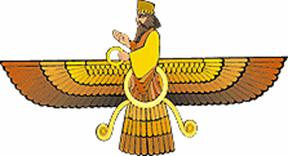OUR PERSIAN HERITAGE
“Persia,” the core of the Persian Empire, is derived from the ancient Greek name for Iran's maritime province, called Fars in the modern Persian language, Pars in Middle Persian and Pārsā in Old Persian, a word meaning "above reproach". The country was referred to as Persia by outsiders, but internally it has always been Iranzamin, which stands for The Land of Iran. The word "Iran" is derived from the root Arya, and the word "Aryans" refers to the Indo-European branch of peoples who settled in Iran thousands of years ago. Ancient Aryans were Mazdyasni Zarathushtrians, which means Worshippers of Ahura Mazda (the word for God) as revealed by their ancient prophet Zarathushtra.
The Aryans of Iranzamin are known as Persians and their language is Parsi, nowadays called Farsi.
During the Achaemenid (Hakhamaneshian) rule, the Zarathushtrian religion became a defining element of the Persian culture. And, during the Sassanid (Sassanian) era, it became the official state religion, and spread outside to other lands.
Zarathushtrian priests were called Magi (the origin of the English words Magic and Magician). Today, the word Magi is used to denote the Three Wise Men (Magi), who came "from the East to Jerusalem, following a bright star,” to worship infant Jesus. Hence, the Magi were said to be the first people to symbolically acknowledge Jesus as the "King of the Jews."
The Zarathushtrian faith is based on two primary forces: good and evil – good enriches life and evil threatens it. (More information is included in the Zartoshti Faith section of this family tree.)
Faravahar – or Faroohar -- one of the primary Zarathushtrian symbols, the depiction of a Fravashi (guardian spirit).
But, during the 7th Century AD, Arabs from the land known as Saudi Arabia conquered Iranzamin and destroyed the Persian Empire.
Ruins of Takht-e-Jamshid (Persepolis), the ceremonial capital of the Persian Empire, is located in the Fars Province of Iran.
The invaders were Moslems and believed the more people of the world they converted to Islam, the better place they themselves would enjoy in Heaven. To that end, they aimed at converting all Persians to Islam, forbidding them to practice Zarathushtrianism. They also vigorously tried to eradicate the Persian culture.
In addition, the captors forced the captives to abandon their Persian language and identity and, instead, to speak Arabic and adopt Islamic names. However, they could not impose the Arab way of life and culture on Persians. Ironically, those Arabs who became Iranzamin’s permanent residents eventually were molded into the Persian culture and lifestyle; some even adopted Persian names.
Hence, with the collapse of the Sassanid Empire, other Iranzamin provinces also fell to the Arabs who, in less than a decade, captured all Persian cities, including Esfahan, the city called home by our family. The city’s invasion was fierce and caused the cultured Esfahan residents to popularize the verse: Arab dar biaban malakh mikhorad. Sag-e Esfahan aab-e yakh mikhorad. (Arabs in the Arabian Desert eat grasshoppers. Dogs in Esfahan enjoy cold spring water.)
The Arabs also conquered present day Iraq (then part of the Persian Empire) following the battle of Kadisiya (Arabic: al-Qadisiyyah) near the Euphrates River (Farat). And they sacked Ctesiphon (Tisfoon) – the world’s largest city at that time, and the imperial capital of the Sassanids -- located in an area called Madayen on the east bank of the Tigris River (Dejleh).
Ctesiphon (Tisfoon) ruins lie about 35 kilometers south of Baghdad.
Consequently, Persians came under the subjection of a series of Arab rulers called the Umayyad Caliphate (Bani Omayeh Khalifehs) for over a century before native Persian dynasties gradually drove them out. And, by then most Persians had already accepted Islam as their religion and had adopted Arabic names, but all had maintained their cultural rites and many had refused to give up their faith and identity. In fact, a large group of Zarathushtrians fled to India where they live today and are known as Parsees (Persians).
Furthermore, thanks to the efforts of the well-known Persian Poet Ferdowsi (935–1020) and his book Shahnameh (The Epic of Kings), the Persian (Parsi/Farsi) language was revived, Persian names -- mostly Aryan or derived from the Zarathushtrian holy book, Avesta – became popular again and the Persian culture was revitalized.
For thirty years, I endured much pain and strife,
With this Parsi I gave Persians verve and life.
I’ve become deathless, the eternal lord,
For I have spread the seed of the word.
Iranians today continue to practice their traditional cultural rites, and the Zarathushtrian religion also exists in parts of Iran and around the world. In Iran, the Zarathushtrian center is located in the city of Yazd in the central part of the country. And Yazd is where our ancestors hailed from.
This Zarathushtrian center is located in the city of Yazd.





